
Olympic trampolining is a highly exhilarating event that combines agility, strength, and aerial skills. Since its inclusion in the Sydney 2000 Games, it has captivated audiences worldwide with its high-flying acrobatics and precise, choreographed routines. In this blog, we will uncover seven surprising facts about this dynamic sport, diving into its history, technology, and the extraordinary abilities of its athletes.
1. Origins of Trampolining

Trampolining has its roots in the early 20th century, when George Nissen, an Iowa-based gymnast and engineer, invented the first modern trampoline in 1936. Inspired by the sight of circus trapeze artists using safety nets for aerial tricks, Nissen, along with his coach Larry Griswold, constructed the prototype using a metal frame and a canvas bed. This creation was initially called the “rebound tumbler.”
The trampolines appeal quickly spread beyond training athletes; it became popular in schools, military training, and recreational settings. As it grew in popularity, the sport formalized with the establishment of the first World Championships in 1964 in London. This milestone was crucial in the sport’s development and helped pave the way for its recognition by the International
Gymnastics Federation (FIG) in the 1990s.
Trampolining made its Olympic debut at the Sydney 2000 Games, a significant achievement that marked its transition from a recreational pastime to a competitive Olympic sport. This progression underscores the sport’s unique combination of fun, athleticism, and technical precision, capturing the imagination of participants and spectators around the world.
2. Trampoline Design and Technology
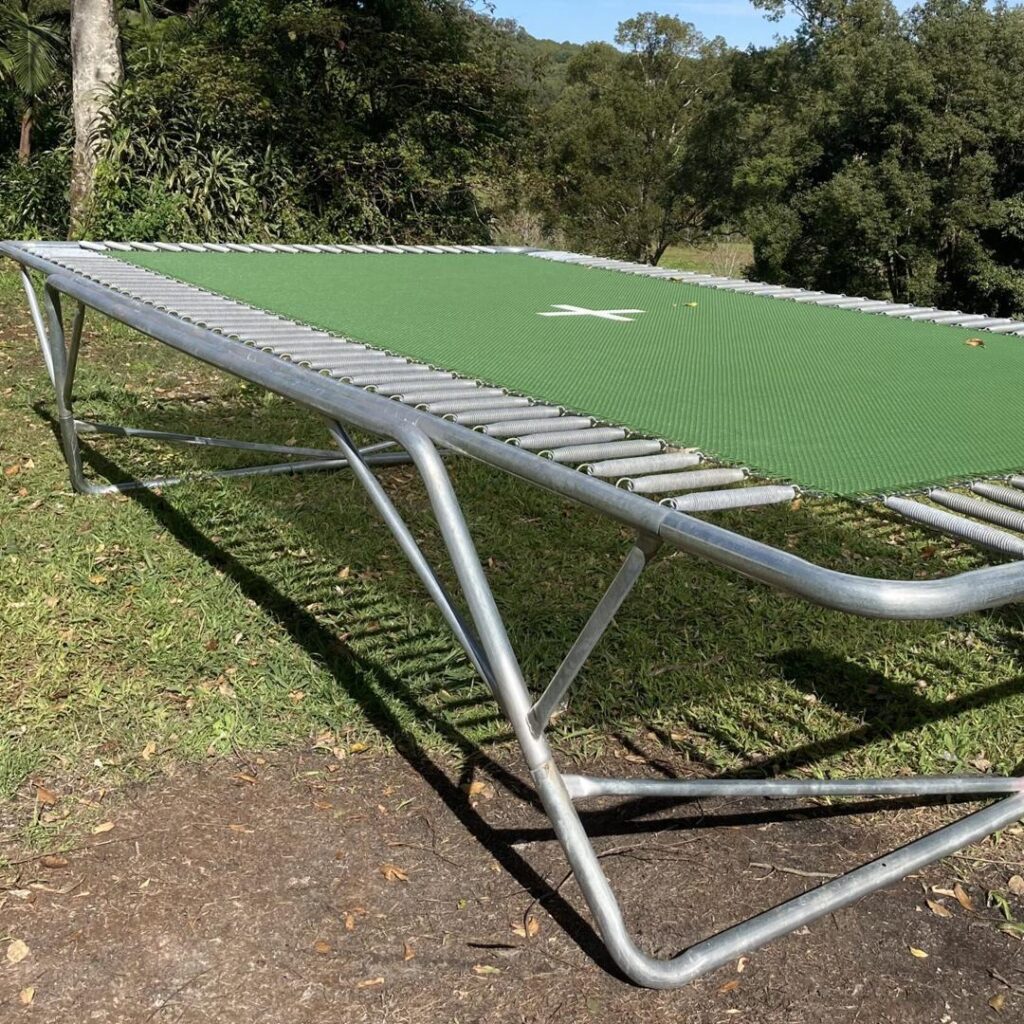
Competitive trampolines are engineered for peak performance, emphasizing safety, durability, and power. Unlike recreational models, these trampolines incorporate advanced design features to support complex aerial maneuvers.
- Frame Construction: Made of steel, the frame provides the necessary sturdiness and rigidity to withstand the intense forces of competitive routines, yet is designed for easy assembly and transport.
- Bed Material: Instead of typical backyard trampoline mesh, the competition trampoline bed is crafted from a durable, woven synthetic material like nylon. This choice ensures a consistent rebound and withstands high tension during jumps. The bed is tightly fitted to the frame, measuring approximately 14 feet by 7 feet, to enhance performance.
- Springs: Connecting the bed to the frame, competitive trampolines utilize 100-120 long steel springs, more than those found in standard models. These springs are designed to optimize bounce and reduce energy loss, enabling athletes to reach heights up to 10 meters (33 feet).
- Technological Advancements: Material and engineering advancements have led to more responsive trampolines, allowing for greater heights and more complex maneuvers. Innovations include aerodynamic beds and improved spring configurations, alongside safety enhancements such as frame padding.
For those intrigued by the intricate design and technology behind competitive trampolines, Akrobat’s In-ground trampolines are engineered with the same attention to performance and safety, making them a top choice for aspiring athletes and enthusiasts alike
3. Scoring System
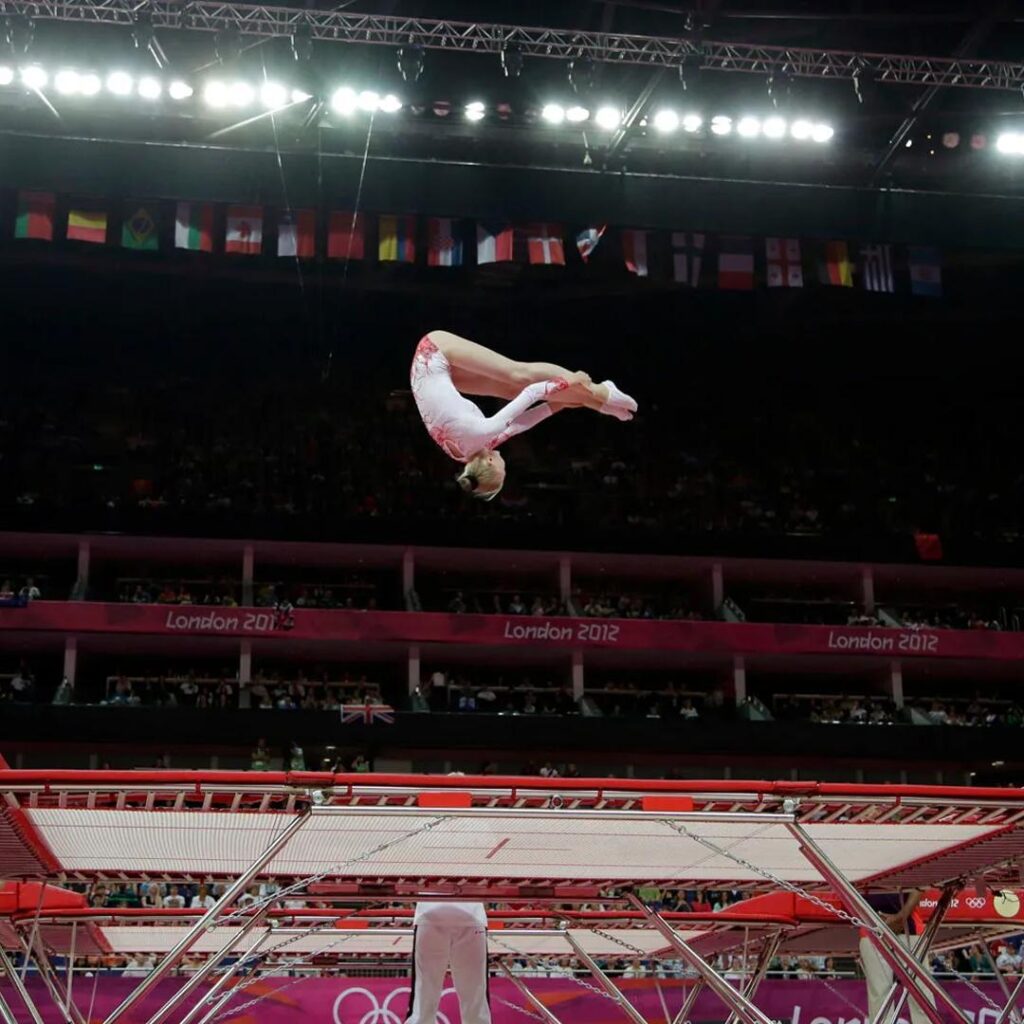
The scoring system in Olympic trampolining is meticulously structured, focusing on three key components: difficulty, execution, and time of flight. Each aspect is critical in determining the athlete’s final score.
Difficulty: This score is based on the complexity of the maneuvers performed during the routine. Each move has a predefined difficulty value, with more complex maneuvers (involving multiple flips and twists) scoring higher. The total difficulty score is the sum of all maneuvers performed in the routine.
Execution: Execution scores assess the quality of each maneuver, including form, control, and landing. Judges look for precise technique, minimal form breaks, and controlled landings. The execution score starts from a perfect 10 and deductions are made for any form errors or lack of control.
Time of Flight: Introduced to enhance the objectivity of scoring, this metric measures the total time an athlete spends in the air during their routine. The longer the time of flight, the higher the score, rewarding athletes for higher and longer jumps.
Judges evaluate each routine by combining these scores, with the final score reflecting the sum of difficulty, execution, and time of flight, adjusted for any penalties or deductions. This comprehensive scoring system ensures that performances are evaluated fairly and consistently, emphasizing both technical prowess and artistic execution.
4. Athletic Requirements
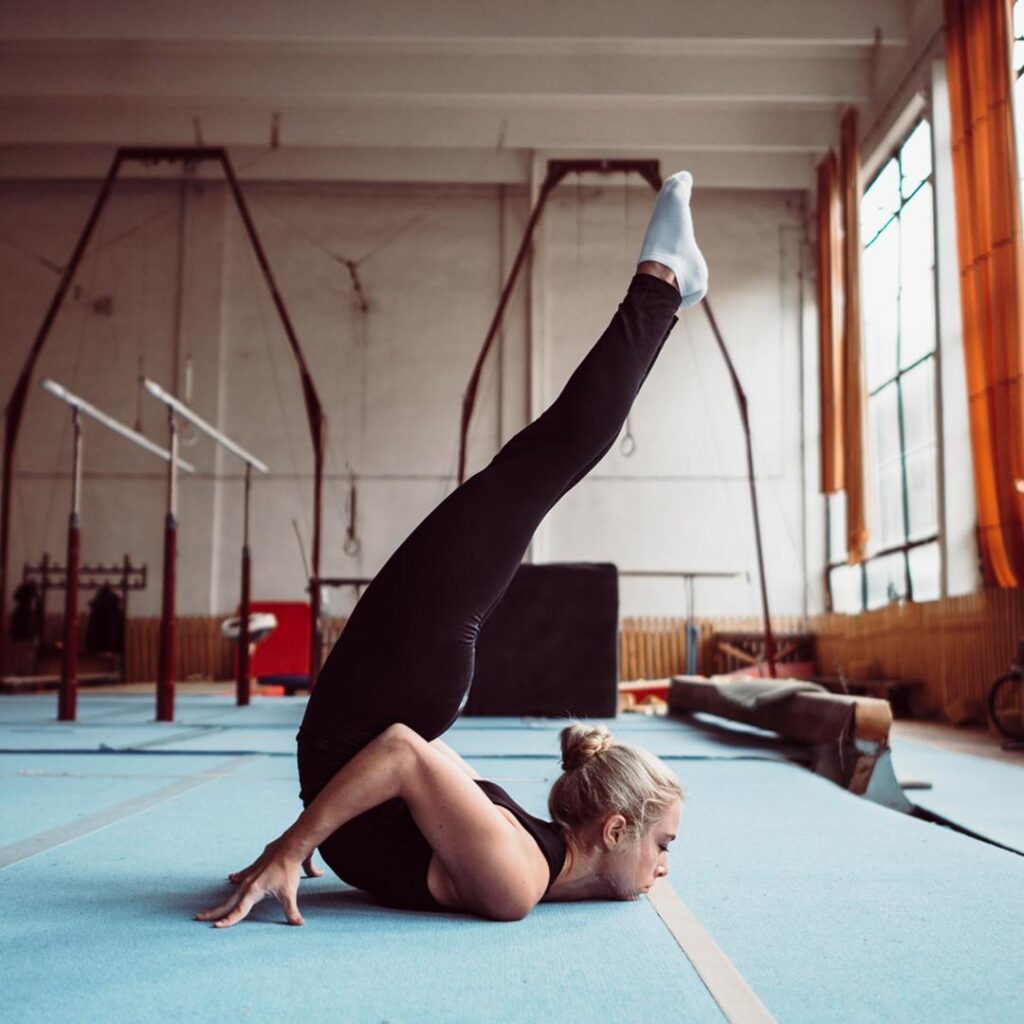
Trampoline gymnastics demands a unique blend of physical prowess and technical skill, requiring athletes to hone their abilities in several key areas.
Physical and Technical Skills
- Strength: Trampolinists need upper and lower body strength to execute powerful take-offs and maintain control during complex maneuvers.
- Flexibility: High levels of flexibility are essential for achieving optimal body positions mid-air and executing seamless transitions between maneuvers.
- Aerial Awareness: Athletes must possess keen spatial awareness to precisely control their body movements while airborne, ensuring accurate landings and smooth transitions between skills.
Training Regimen and Techniques
- Rigorous Training: Successful trampolinists follow a rigorous training regimen that includes strength and conditioning exercises, flexibility training, and hours of practice to refine technique and build endurance.
- Specialized Techniques: Athletes employ specialized techniques such as visualization and mental rehearsal to perfect routines and overcome performance pressure. Coaches play a crucial role in providing technical guidance and feedback to help athletes refine their skills and reach their full potential.
Athletes and trainers looking for equipment that matches their dedication to achieving excellence in trampoline gymnastics can rely on Akrobat Sport trampolines, which are designed to support even the most demanding routines.
Also, learn how Impactful is Sport Trampoline On Athletics And Sports!
5. Injury Prevention and Safety Measures

Trampolining, like any sport, comes with inherent risks, but misconceptions about its safety can often be exaggerated. With proper precautions and the use of advanced safety equipment, the risk of injury can be significantly reduced.
Common Misconceptions:
- High Injury Rate: Many believe that trampolining is exceptionally dangerous. While injuries can occur, competitive trampolinists train with meticulous technique and supervision, which significantly lowers the risk compared to casual, unsupervised backyard trampoline use.
- Severe Injuries Only: Another misconception is that trampolining injuries are always severe. In reality, most injuries are minor, such as sprains and bruises, and severe injuries are rare when safety protocols are followed.
Safety Protocols and Equipment:
- Supervised Training: Professional trampolinists train under strict supervision and guidance, with coaches who enforce proper technique and safety measures.
- Safety Harnesses: During training, especially when learning new skills, athletes often use safety harnesses. These harnesses prevent falls and allow athletes to attempt new maneuvers without the risk of a severe crash landing.
- Padded Frames and Decks: All competitive trampolines are equipped with padded frames and decks, which cover the springs, frame, and surrounding areas to prevent injury upon accidental falls.
- Spotters: During both training and competition, spotters are present around the trampoline. These trained individuals are ready to intervene if an athlete loses control, helping to prevent injury.
Understand the importance of safety in the sport, Akrobat family trampolines include advanced safety features such as padded frames and decks, and are constructed using high-quality materials to ensure a safe and enjoyable experience for all users.
6. Notable Olympic Moments
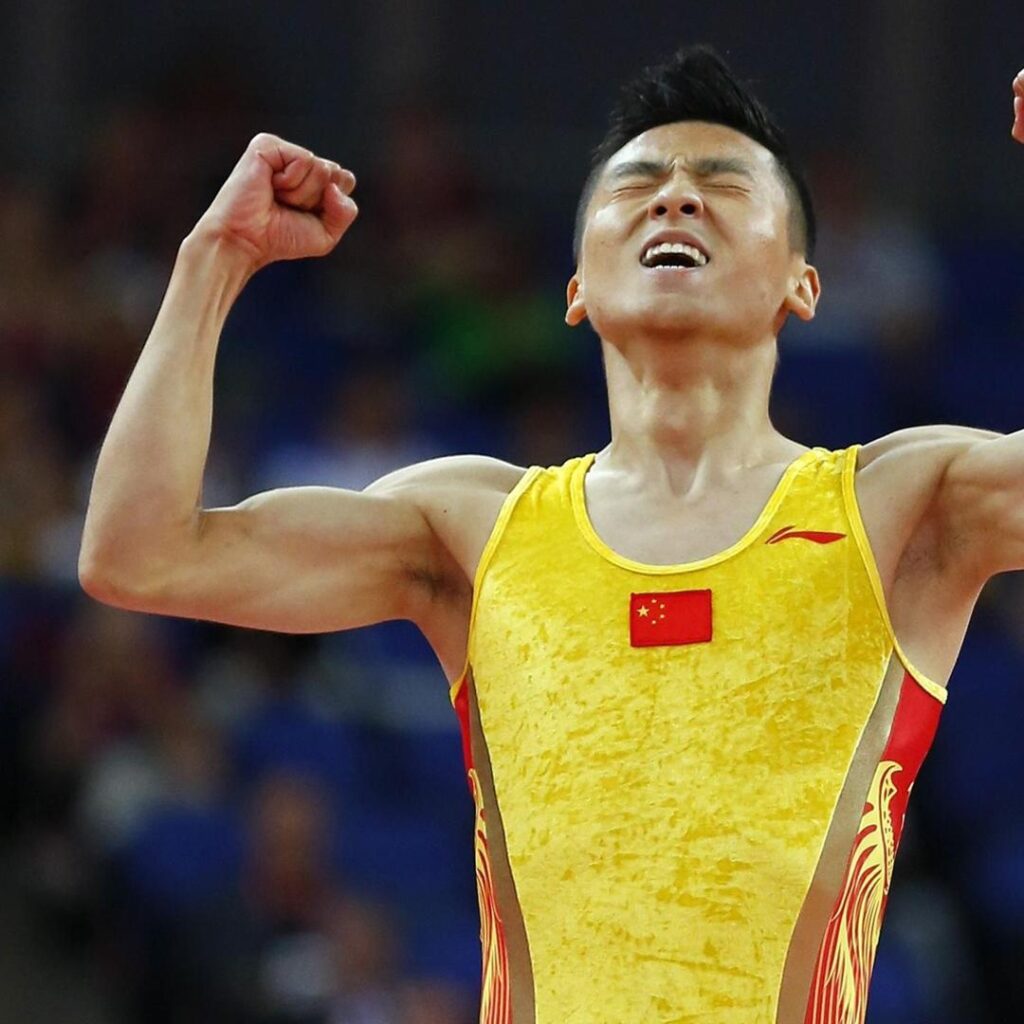
Olympic trampolining has provided a stage for some remarkable performances and memorable moments since its introduction in the 2000 Sydney Games. Here are a few standout instances that have defined the sport:
Standout Performances and Records:
- Karen Cockburn: The Canadian trampolinist has been instrumental in shaping Olympic trampolining, securing medals in three consecutive Olympics (2000, 2004, 2008), helping to popularize the sport in North America.
- Dong Dong: The Chinese athlete is one of trampolining’s most decorated figures, achieving a historic feat by medaling in three consecutive Olympics, including gold in 2012 in London, silver in 2016 in Rio de Janeiro, and bronze in 2008 in Beijing.
- Rosannagh MacLennan: Representing Canada, MacLennan has won back-to-back Olympic gold medals in 2012 and 2016, marking her as one of the sport’s most successful athletes. Her 2012 victory was particularly notable as it was Canada’s only gold of the Games.
Iconic Athletes and Anecdotes:
- Irina Karavaeva: As the first Olympic gold medal
winner in trampolining during the 2000 Sydney Games, Russian athlete Irina Karavaeva set the standard for excellence in the sport. Her pioneering achievement not only earned her a place in
Olympic history but also inspired a generation of trampolinists.
- Lei Gao: In 2008, Lei Gao of China delivered a performance that combined technical mastery and dramatic flair, captivating the Beijing audience and securing the gold medal. His victory was particularly poignant as it was on home soil, enhancing the significance of his achievement.
- Bryony Page: The British trampolinist made a significant impact at the 2016 Rio de Janeiro Olympics by securing a silver medal, Britain’s first Olympic trampolining medal. Her emotional reaction and unexpected success won the hearts of viewers and highlighted the personal and emotional journey Olympic athletes often undergo.
Each competition and athlete adds to the rich narrative of Olympic trampolining, making it a must-watch event for fans around the world.
7. Trampoline in Popular Culture
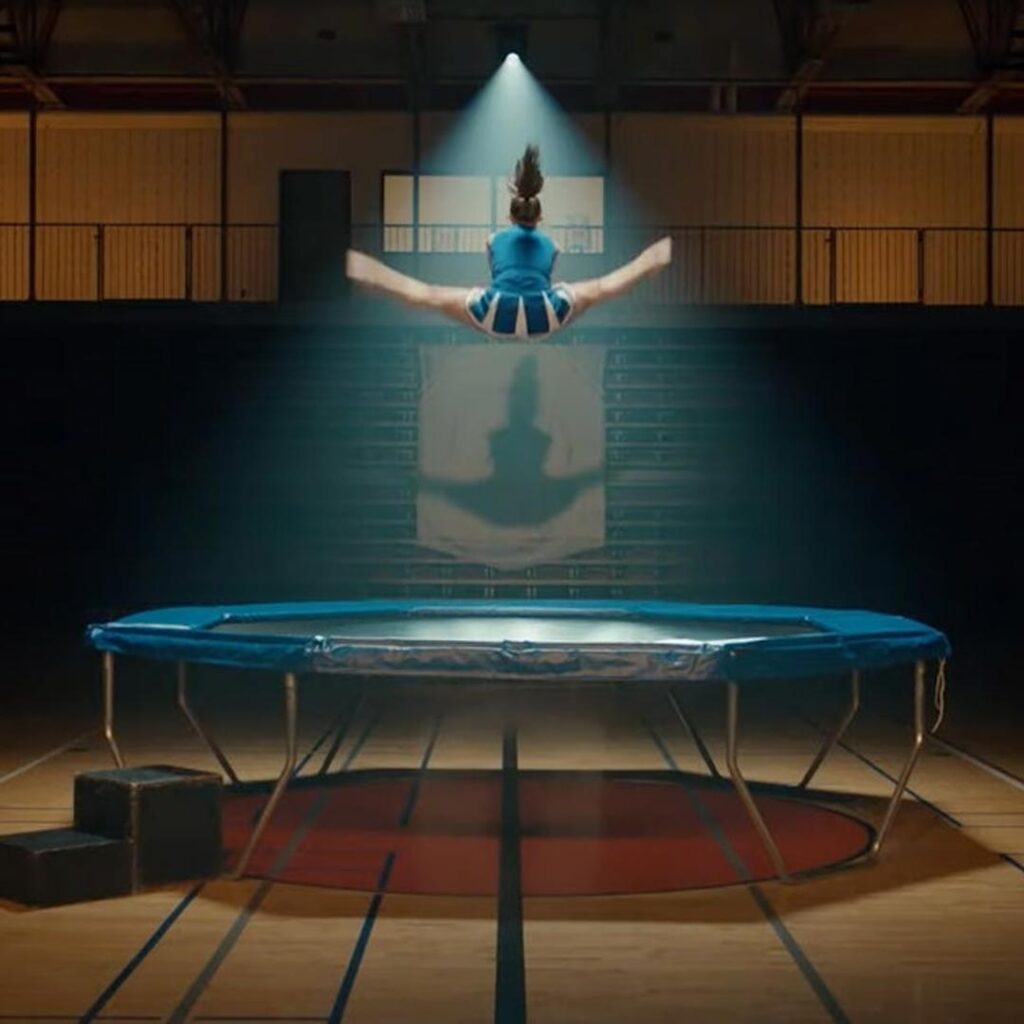
Trampolining has made notable appearances in popular culture, enhancing its visibility and appeal beyond the sports community. From cinematic moments to social media trends, the sport’s dynamic nature has captured the imagination of audiences worldwide.
Portrayal in Media:
- Movies and TV Shows: Trampolines often feature in films and television as a symbol of fun and youthful exuberance. Classic scenes, such as Homer Simpson’s backyard antics with a trampoline in “The Simpsons,” humorously highlight the device’s playful side, though occasionally they also showcase impressive athletic feats.
- Viral Videos: The internet age has seen trampolining take center stage in countless viral videos, showcasing everything from spectacular tricks to humorous fails. These clips often gain significant traction on platforms like YouTube, TikTok, and Instagram, spreading rapidly across the globe.
Impact on Sport Awareness:
- Mainstream Exposure: This portrayal in media and online platforms plays a critical role in promoting trampolining. It not only introduces the sport to wider audiences but also highlights its accessibility and fun factor, encouraging participation at all levels.
- Appreciation for Athleticism: As viewers witness the complexity and skill involved in competitive trampoline routines, either through Olympic broadcasts or curated social media content, there is a growing appreciation for trampolining as a serious sport. This recognition is vital for its development and the support of emerging athletes.
Through its integration into popular culture, trampolining has not only gained a broader audience but has also helped to foster a deeper understanding and respect for the sport, demonstrating its blend of entertainment, athleticism, and artistry.
Bringing the Bounce: Adding a Trampoline to Your Garden
Incorporating a trampoline into your garden offers numerous benefits and can transform your outdoor space into a hub of activity and joy. Here’s why having a trampoline is beneficial, what types are best suited for garden spaces, and the top three brands in the UK to consider when making your purchase.
Benefits of a Garden Trampoline
- Health and Fitness: Regular use of a trampoline can improve cardiovascular health, enhance balance, and strengthen the muscles of the legs, back, and abdomen. It’s a fun way to encourage physical activity among all family members.
- Family Fun: A trampoline provides endless entertainment for children and adults alike, fostering family bonding and ensuring kids have a compelling reason to play outside and away from screens.
- Stress Relief: The rhythmic motion of jumping on a trampoline is known to reduce stress and anxiety, making it a perfect leisure activity to unwind.
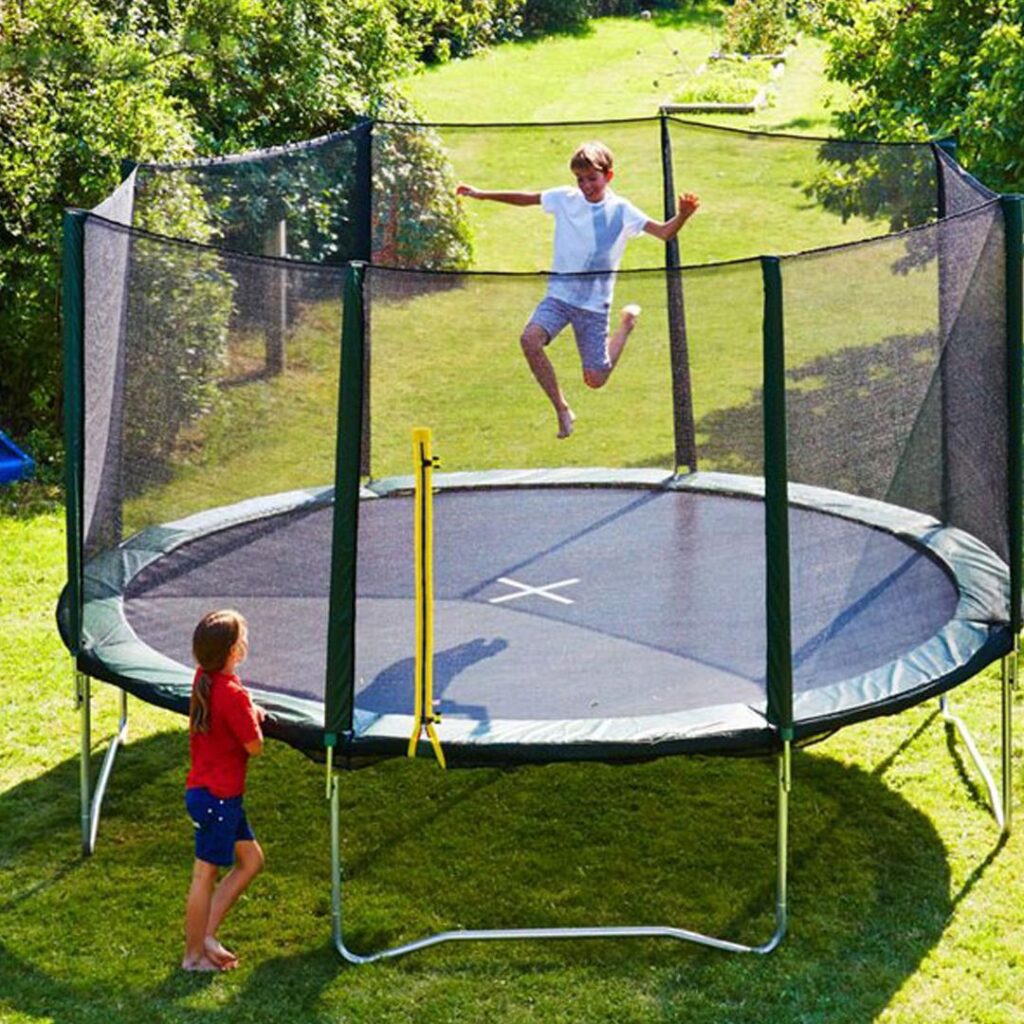
Best Types for Your Garden
- Spring-Based Trampolines: These traditional trampolines are popular due to their bounce efficiency and variety in sizes, making them suitable for most garden sizes.
- Fitness Trampolines: Also known as mini trampolines or rebounders, fitness trampolines are smaller and often used for exercise routines. They’re perfect for gardens where space is limited and are excellent for enhancing cardiovascular health and coordination.
- In-Ground Trampolines: Installed at ground level, these trampolines provide a safer and more aesthetic option as they blend seamlessly with the garden landscape. Their flush-to-ground design minimizes the risk of falling from a height, making them a great choice for families with young children or aesthetic-conscious gardeners.
Important Tip – When considering a garden trampoline, having high-quality trampoline accessories is paramount.
Conclusion
Trampolining has evolved significantly from its humble beginnings to become a thrilling Olympic sport, thanks to continual advancements in design and technology. Today’s competitive trampolines are engineered to maximize performance and safety, allowing athletes to push the boundaries of aerial gymnastics. As technology progresses, we can expect trampolining to reach even greater heights, captivating audiences and challenging participants with its dynamic potential.





